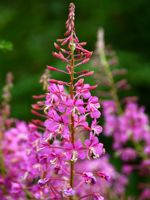Mon-Fri 9am - 5pm Mountain time
Fireweed vs Blue Flax
Chamaenerion angustifolium (Epilobium angustifolium)
Linum lewisii
CUSTOM GROW
NOT AVAILABLE THIS SEASON - MIGHT RETURN
Fireweed is a native perennial wildflower known for its tall spikes of bright pink to purple blooms. Its long-lasting summer flowers are an important nectar source for pollinators such as bees, butterflies, and hummingbirds, while its seeds provide food for birds. Its showy, long-lasting display makes it visually striking in naturalized plantings.
Fireweed gets its namesake because it is often one of the first species to return after wildfires, supporting ecosystem recovery. Its wind-dispersed seeds allow it to spread readily, making it highly effective in large-scale restoration, revegetation, and naturalization projects.
Fireweed is the Provincial Flower of the Yukon.
Blue Flax is a native perennial wildflower known for its blue to violet flowers. Each flower lasts just a single day, but new blooms appear continuously, providing weeks of colour. This extended flowering period provides a reliable display from late spring into summer and attracts a variety of pollinators.
They can self-seed readily, so removing spent blooms helps manage their spread. Birds feed on the seeds, and when cooked, they are edible and are described as having a mild, nutty flavour. The plant grows in loose clumps with slender stems and fine foliage. Young plants are leafy, but as they mature, most leaves are shed.
Blue Flax grows well in a wide range of soils, including poor or sandy conditions, and is drought-tolerant once established. The deep root system helps to stabilize soil and prevent erosion. They are well-suited for pollinator gardens, restoration, naturalization, and xeriscaping projects.
Fireweed Quick Facts
Blue Flax Quick Facts
Toxicity: toxic to some animals, raw seed toxic

